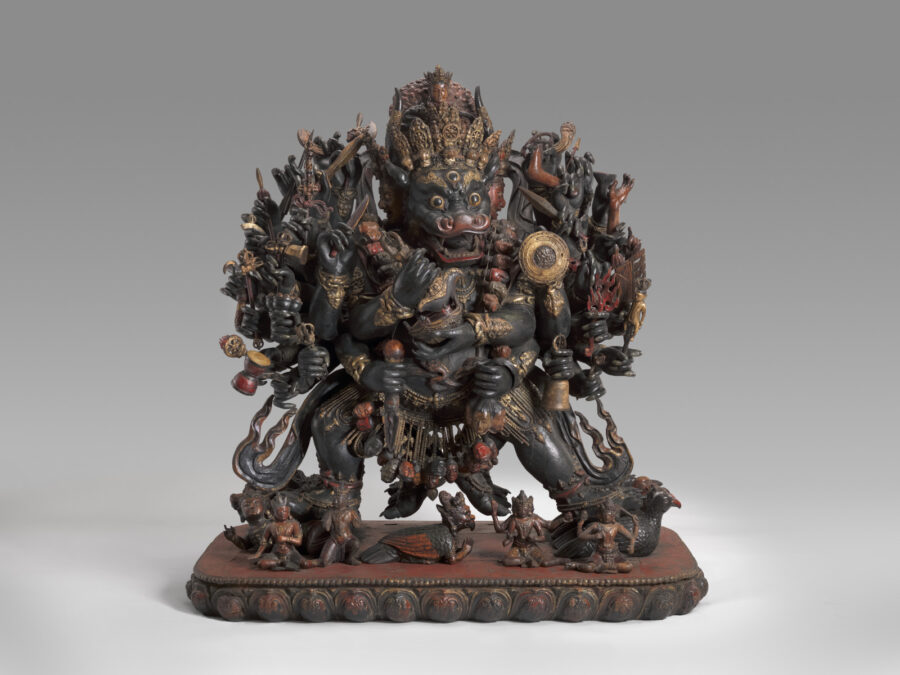


Soon after entering the exhibition Awaken, you soon come face to face with an artwork that exemplifies Buddhist enlightenment. The powerful stone sculpture depicts the Indian prince Siddhartha Gautama at the instant he became a Buddha—Sanskrit for an Awakened One. More than a millennium after its creation, the sculpture still tells the enduring story of the historical Buddha’s meditative transformation under the bodhi tree, whose leafy branches appear above his head.

The Buddha Triumphing over Mara; India, probably Bihar; ca. 800–900; stone; 21¾ × 14 3/8 × 5 in. (55.2 × 36.5 × 12.7 cm); Asian Art Museum of San Francisco; The Avery Brundage Collection, B61S7+.
Awaken offers more than just the opportunity to learn about enlightenment. It invites visitors to actually join a journey toward awakening. But an awakening from what? To discover what? You will see for yourself—and we don’t mean that figuratively—for the transformational trek that unfolds through the galleries is facilitated by art, like many such journeys in Himalayan Buddhist traditions. You don’t simply look at these objects, you look into them—and there, see yourself.
Art’s role as a medium for self-examination and a catalyst for change is captured in two synonyms for Tibetan Buddhism’s characteristic scroll paintings. Best known as thangka (rolled art), they are also described as melong (mirror) and thong drol (visual liberators). By inviting us to reflect on the relationships between ourselves and our perceptions, art can help free us from our habitual misperceptions of ourselves and reveal our true place in the world.
To see how this relationship between art and self-discovery works, let us look at—or rather into—four artworks in Awaken. Each depicts the Buddhist deity Vajrabhairava, the Lightning Terror. The sequence of images, like the exhibition itself, charts a course from the confusion of the ordinary world toward the clarity of the soon enlightened mind.

Tsherin Sherpa (American, b. 1968 in Nepal); Luxation 1; 2016; acrylic on sixteen stretched cotton canvases; each 18 × 18 in. (45.7 × 45.7 cm); Virginia Museum of Fine Arts; Adolph D. and Wilkins C. Williams Fund, 2017.195a-p.
By inviting us to reflect on the relationships between ourselves and our perceptions, art can help free us from our habitual misperceptions of ourselves and reveal our true place in the world.
The first of these images—in fact the very first artwork in the exhibition—is confusing indeed. Sixteen brightly painted canvases feature pieces of a larger image of Vajrabhairava, but the small gaps between them create chasms of missing information, preventing the picture from coalescing. Contemporary artist Tsherin Sherpa’s Luxation 1 reveals the chaos and fragmentation of everyday experience. We can recognize certain elements of the deity, but their sum and true significance is unclear. Like its title—meaning dislocation or displacement—suggests, the painting illustrates that our vision, particularly of ourselves, is often fractured into disjointed pieces.

Mandala of Vajrabhairava; Ngor Monastery, Tibet; 1650–1750; colors on cotton; image 16 ½ × 15 ¾ in. (41.9 × 40 cm); Asian Art Museum of San Francisco; The Avery Brundage Collection, B63D5.
Vajrabhairava is next revealed to us by a Tibetan teacher, a lama, whom we meet in the form of a vibrant thangka painted four centuries ago. Gorampa Sonam Sengge was a fifteenth-century abbot of Ngor Monastery, and he now assumes the role of our guide in the journey toward awakening. That journey is not a physical one, but instead a meditative expedition into a set of teachings described in another painting called a mandala. Gorampa gradually leads us to the very center of this mandala where Vajrabhairava is illustrated—now fully formed but in such a miniscule scale that he is still difficult to discern.

Vajrabhairava; Sino-Tibetan; 15th century or later; polychromed wood; 53 ¼ × 50 ¾ × 30 ¾ in. (135.3 × 128.9 × 78.1 cm); Virginia Museum of Fine Arts; E. Rhodes and Leona B. Carpenter Foundation and Arthur and Margaret Glasgow Fund, 93.13a-oo.
That tiny depiction, however, soon comes into large-as-life focus. The meditative journey is not simply a study of the mandala, but instead a visualization of oneself actually traversing the world it describes. A ring of colorful filigree is a wall of fire to be crossed; a circle of multi-hued petals defines a cosmic lotus flower to be scaled; and the large central square is a vast, multistory palace entered through gateways in the four directions. At each juncture of the journey into the mandala—and progress through the exhibition—you meet strange beings and learn, or rather experience, another piece of the mandala’s teachings. The culminating encounter, and the core message of these teachings, occurs at the mandala’s center, where we confront Vajrabhairava himself—transformed from that postage stamp-sized painting into a large, dramatic, intentionally terrifying three-dimensional embodiment of the thirty-four-armed buffalo-headed deity.
Here we learn the true identity and significance of Vajrabhairava, the Lightning Terror. Known also as Yamantaka, Death Slayer, he is a wrathful manifestation of the benevolent Bodhisattva of Wisdom Manjushri. A Buddhist story—at once myth and philosophy—narrates this astonishing transformation. Once upon a time, Yama, the Lord of Death, went on an uncontrolled rampage. To prevent Yama from devouring the entire cosmos, the Bodhisattva of Wisdom devised a clever stratagem. He turned himself into a great mirror and beckoned Yama to look at him. What Yama saw in Manjushri was Vajrabhairava: simultaneously his own mirror image and the figure of his conqueror. Buddhist Wisdom thus defeated Death by revealing to him his true nature as impermanence embodied. In turn, when we confront this stunning image, we too gaze into a mirror exposing the reality of our mortality and reminding us that our fear of death can be conquered only through facing its inevitability.
The experience of nonduality reverses the fragmentation of our usual interactions with the ordinary world.

Vajrabhairava and Vajravetali; Central Tibet; mid-15th century; opaque watercolor and gold on cloth; framed 46 ¼ × 38 ¾ in. (117.5 × 98.4 cm); Virginia Museum of Fine Arts; Zimmerman Family Collection, Robert A. and Ruth W. Fisher Fund and Arthur and Margaret Glasgow Fund, 2010.85.
Following this catharsis, visitors to Awaken encounter one last painting of Vajrabhairava. He is not alone but appears embracing his consort Vajravetali. His previously ink-black body, merging with hers, is transformed into radiant gold and shimmers like a mirror. Known as a yab-yum, or father-mother form, the pair illustrates a specific lesson: that apparent opposites, like subject and object, mind and matter, or life and death, are not mutually exclusive but rather mutually constitutive. Sufficient meditation upon such images can lead to an experience of nonduality, the realization that an apparent object is, in truth, non-different from one’s own mind.
This is the glimpse of awakening that we hope visitors to the exhibition will take away with them: that all we perceive is a product of the mind. Far from implying that nothing should be taken seriously, it is a reminder that everything is important—every event, every being has a unique place in the infinite causal interconnections that make up the Buddhist universe. The experience of nonduality reverses the fragmentation of our usual interactions with the ordinary world and restores awareness to its proper place, not as the passive receptor of experience but as an active generator of it, capable of encompassing subject and object simultaneously and discerning unity.

Standing Crowned Buddha with Four Scenes of His Life; Bihar, southern Magadha region, India; ca. 1050–1100; basalt; 41 × 20 × 7 in. (104.1 × 50.8 × 17.8 cm); Asian Art Museum of San Francisco; The Avery Brundage Collection, B65S11.
The final artwork in Awaken is a sculpture with many similarities to the one with which we began. Both depict a Buddha, an Awakened One, but in this final image you are encouraged to see not only Buddhism’s historical founder but also a reflection of your own buddha-nature. Standing before the figure—and recalling the encounter with Wisdom’s mirror and the experience of nonduality—you are asked to consider the question, “Am I in the world, or is the world in me?” We hope you have woken to find out that the answer is simply yes, that as Grateful Dead collaborator and lyricist Robert Hunter once put it, you are the eyes of the world.
Awaken: A Tibetan Buddhist Journey Toward Enlightenment was on view at the Rubin Museum from March 12, 2020, to January 3, 2021. It was organized by the Virginia Museum of Fine Arts and also presented at the Asian Art Museum of San Francisco.

Jeffrey S. Durham is associate curator of Himalayan art at the Asian Art Museum of San Francisco. His exhibitions include Enter the Mandala, A Guided Tour of Hell, and Divine Bodies. Prior to this role, he served as professor of religion at the University of North Carolina and St. Thomas Aquinas College. As a curator and scholar, Dr. Durham focuses on the imagery and philosophy of esoteric religious traditions.

John Henry Rice is the E. Rhodes and Leona B. Carpenter Curator of South Asian and Islamic Art at Richmond’s Virginia Museum of Fine Arts. The breadth of the VMFA’s world-class collections keeps leading him away from his core area of expertise, the arts of medieval and early modern South India. He organized a retrospective exhibition of contemporary Himalayan artist Tsherin Sherpa in 2022.

Rubin Museum
150 W. 17th St., NYC
Get the latest news and stories from the Rubin, plus occasional information on how to support our work.